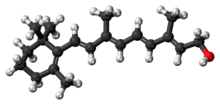 | |
 Retinol | |
| Clinical data | |
|---|---|
| AHFS/Drugs.com | Monograph |
| License data | |
| Routes of administration | By mouth, IM[1] |
| Drug class | Vitamin[2] |
| Legal status | |
| Legal status |
|
| Identifiers | |
| |
| Chemical and physical data | |
| Formula | C20H30O |
| Molar mass | 286.4516 g·mol−1 |
| 3D model (JSmol) | |
| Melting point | 62–64 °C (144–147 °F) |
| Boiling point | 137–138 °C (279–280 °F) (10−6 mm Hg) |
| |
| |
Retinol, also known as vitamin A1, is a vitamin found in food and used as a dietary supplement.[4] As a supplement it is used to treat and prevent vitamin A deficiency, especially that which results in xerophthalmia.[1] In regions where deficiency is common, a single large dose is recommended to those at high risk a couple of times a year.[5] It is also used to reduce the risk of complications in those who have measles.[5] It is used by mouth or injection into a muscle.[1]
Retinol at normal doses is well tolerated.[1] High doses may result in an enlarged liver, dry skin, or hypervitaminosis A.[1][6] High doses during pregnancy may result in harm to the baby.[1] Retinol is in the vitamin A family.[1] It is converted in the body to retinal and retinoic acid through which it acts.[4] Dietary sources include fish, dairy products, and meat.[4]
Retinol was discovered in 1909, isolated in 1931, and first made in 1947.[7][8] It is on the World Health Organization's List of Essential Medicines.[9] Retinol is available as a generic medication and over the counter.[1] The wholesale cost in the developing world is about US$0.02–0.30 per 50,000 units.[10] In the United States it is not very expensive.[11]
References edit
- ^ a b c d e f g h i "Vitamin A". The American Society of Health-System Pharmacists. Archived from the original on 30 December 2016. Retrieved 8 December 2016.
- ^ a b "RETINOL = VITAMIN A oral - Essential drugs". medicalguidelines.msf.org. Archived from the original on 29 August 2021. Retrieved 24 August 2020.
- ^ "WHOCC - ATC/DDD Index". www.whocc.no. Archived from the original on 12 April 2020. Retrieved 15 September 2020.
- ^ a b c "Office of Dietary Supplements - Vitamin A". ods.od.nih.gov. 31 August 2016. Archived from the original on 12 December 2016. Retrieved 30 December 2016.
- ^ a b World Health Organization (2009). Stuart MC, Kouimtzi M, Hill SR (eds.). WHO Model Formulary 2008. World Health Organization. p. 500. hdl:10665/44053. ISBN 9789241547659.
- ^ British national formulary : BNF 69 (69 ed.). British Medical Association. 2015. p. 701. ISBN 9780857111562.
- ^ Squires, Victor R. (2011). The Role of Food, Agriculture, Forestry and Fisheries in Human Nutrition - Volume IV. EOLSS Publications. p. 121. ISBN 9781848261952. Archived from the original on 5 November 2017.
- ^ Ullmann's Food and Feed, 3 Volume Set. John Wiley & Sons. 2016. p. Chapter 2. ISBN 9783527695522. Archived from the original on 5 November 2017.
- ^ World Health Organization (2019). World Health Organization model list of essential medicines: 21st list 2019. Geneva: World Health Organization. hdl:10665/325771. WHO/MVP/EMP/IAU/2019.06. License: CC BY-NC-SA 3.0 IGO.
- ^ "Vitamin A". International Drug Price Indicator Guide. Archived from the original on 27 October 2018. Retrieved 8 December 2016.
- ^ Hamilton, Richart (2015). Tarascon Pocket Pharmacopoeia 2015 Deluxe Lab-Coat Edition. Jones & Bartlett Learning. p. 230. ISBN 9781284057560.